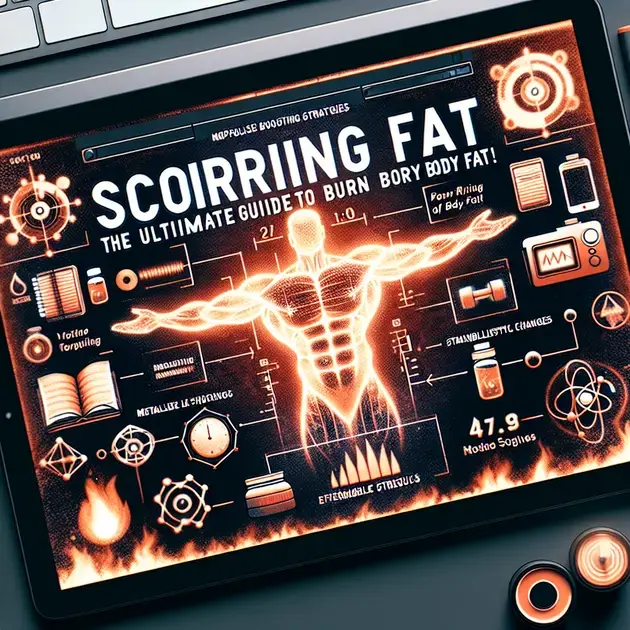When it comes to achieving quick weight loss goals, burning body fat fast is essential. In today’s fast-paced world, more and more people are looking for effective ways to shed excess weight and improve their overall health. This ultimate guide is designed to help you reach your weight loss goals quickly and efficiently.
With the latest research and proven strategies, you’ll learn how to maximize fat burning, boost your metabolism, and make sustainable lifestyle changes for long-term success. Say goodbye to fad diets and hello to a healthier, happier you with this comprehensive guide to burning body fat fast.

The Science Behind Fat Burning Techniques
In order to effectively burn fat, it is important to understand the science behind fat burning techniques. Fat burning occurs when the body utilizes stored fat for energy, typically through a combination of diet and exercise. One popular fat burning technique is high-intensity interval training (HIIT), which involves short bursts of intense exercise followed by brief rest periods. This type of workout has been shown to boost metabolism and increase fat burning.
Another effective fat burning technique is strength training, which helps build muscle mass. Muscles are more metabolically active than fat, meaning that the more muscle you have, the more calories you burn at rest. Incorporating strength training exercises such as weightlifting or bodyweight exercises into your fitness routine can help increase fat burning efficiency.
Additionally, paying attention to your diet plays a crucial role in fat burning. Consuming a balanced diet rich in lean protein, healthy fats, and fiber can help support your metabolism and promote fat loss. Tracking your food intake with apps like MyFitnessPal or Lose It can help you stay on track with your nutritional goals.
Understanding the science behind fat burning techniques can empower you to make informed choices about your exercise and nutrition habits, ultimately leading to more efficient fat loss and improved overall health.
Effective Strategies for Boosting Metabolism
Boosting metabolism is key to enhancing the body’s ability to burn fat and maintain a healthy weight. One effective strategy for boosting metabolism is staying hydrated by drinking plenty of water throughout the day. Dehydration can slow down the metabolic rate, so ensuring adequate water intake is essential.
Another strategy for boosting metabolism is getting an adequate amount of sleep. Lack of sleep can disrupt hormonal balance and negatively impact metabolism. Aim for 7-9 hours of quality sleep each night to support a healthy metabolism.
Incorporating regular physical activity into your routine can also help boost metabolism. Activities like walking, cycling, or yoga can increase calorie expenditure and promote fat burning. Utilizing fitness apps like Strava or Nike Training Club can provide guidance and tracking for your workouts.
Eating small, frequent meals throughout the day can also help keep your metabolism active. Incorporating metabolism-boosting foods such as green tea, chili peppers, and whole grains into your diet can further support a healthy metabolism.
Long-Term Success: Sustainable Lifestyle Changes
When it comes to achieving long-term success in fat burning and weight management, sustainable lifestyle changes are crucial. Crash diets or extreme exercise regimens are often not sustainable in the long run and can lead to rebound weight gain. Instead, focus on making gradual changes that you can maintain over time.
One key aspect of sustainable lifestyle changes is finding enjoyable forms of physical activity. Whether it’s dancing, hiking, or playing a sport, incorporating activities that you love into your routine can make exercise feel less like a chore and more like a fun part of your day.
Setting realistic and achievable goals can also contribute to long-term success. Break down your larger goals into smaller, actionable steps and celebrate your progress along the way. Apps like Habitica or Strides can help you track your goals and build healthy habits over time.
Prioritizing self-care and stress management is another important component of sustainable lifestyle changes. Chronic stress can negatively impact metabolism and contribute to weight gain, so finding ways to relax and unwind, such as meditation or journaling, can support your overall health and well-being.

Maximizing Fat Loss Through Exercise
When it comes to maximizing fat loss through exercise, it’s important to incorporate a combination of cardiovascular workouts and strength training. Cardiovascular exercises such as running, cycling, or swimming help burn calories and improve overall fitness levels. On the other hand, strength training with weights or body-weight exercises helps build muscle mass, which in turn boosts metabolism and increases calorie burn even at rest.
To maximize fat loss, aim for at least 150 minutes of moderate-intensity aerobic activity or 75 minutes of vigorous-intensity activity each week, combined with two or more days of strength training. Additionally, incorporating high-intensity interval training (HIIT) workouts into your routine can help increase calorie expenditure and promote fat loss even further.
It’s also essential to ensure you’re getting enough rest and recovery between workouts to allow your body to repair and grow stronger. Adequate sleep, hydration, and a balanced diet are all crucial components of an effective exercise plan for maximizing fat loss.
Overall, consistency is key when it comes to maximizing fat loss through exercise. Finding activities you enjoy and can stick to in the long term will help you achieve sustainable results and reach your fitness goals.
Healthy Eating Habits for Faster Results
When it comes to achieving faster results with your weight loss journey, healthy eating habits play a crucial role. Incorporating a balanced diet rich in whole foods such as fruits, vegetables, lean proteins, and whole grains can help support your weight loss efforts and improve overall health.
One key tip for faster results is to focus on portion control and mindful eating. Pay attention to your hunger cues, eat slowly, and savor each bite to prevent overeating. Planning and preparing meals ahead of time can also help you make healthier choices and avoid the temptation of fast food or processed snacks.
Another important aspect of healthy eating habits is staying hydrated and avoiding sugary beverages. Opt for water, herbal teas, or infused water to stay hydrated and support your metabolism. Limiting your intake of refined sugars and processed foods can also help accelerate fat loss and improve energy levels.
Lastly, incorporating regular meals and snacks throughout the day can help keep your metabolism active and prevent excessive hunger, which can lead to overeating. By fueling your body with nutritious foods at regular intervals, you can maintain steady energy levels and support your weight loss goals.
Breaking Through Weight Loss Plateaus
Experiencing a weight loss plateau can be frustrating, but there are strategies you can implement to break through and continue making progress towards your goals. One effective way to overcome a plateau is to reassess your diet and exercise routine. Look for areas where you can make improvements, such as increasing the intensity or duration of your workouts, or adjusting your caloric intake to ensure you’re in a calorie deficit.
Changing up your exercise routine can also help jumpstart weight loss progress. Try incorporating new activities, varying the intensity of your workouts, or focusing on different muscle groups to challenge your body in new ways. Stepping out of your comfort zone can reignite your metabolism and stimulate fat loss.
In addition to adjusting your exercise routine, paying attention to your stress levels, sleep quality, and overall lifestyle habits can play a significant role in overcoming a weight loss plateau. Stress and lack of sleep can negatively impact your metabolism and hormone levels, making it harder to lose weight. Taking steps to prioritize self-care, relaxation, and adequate rest can help support your weight loss efforts.
Remember that weight loss plateaus are a natural part of the journey, and it’s essential to stay patient and persistent. By implementing these strategies and staying committed to your health and fitness goals, you can break through plateaus and continue on the path to long-term success.
Conclusion
Maximizing fat loss through exercise requires a strategic approach that combines cardiovascular workouts and strength training. Cardio exercises like running, cycling, or swimming are key in burning calories and enhancing overall fitness levels. Pairing these with strength training, whether through weights or body-weight exercises, helps build muscle mass, boosting metabolism for increased calorie burn even at rest.
To achieve optimal fat loss, aim for a minimum of 150 minutes of moderate-intensity aerobic activity or 75 minutes of vigorous-intensity activity weekly, complemented by two or more days of strength training. Introducing high-intensity interval training (HIIT) into your routine can further elevate calorie expenditure, aiding in effective fat loss.
Additionally, proper rest and recovery between workouts are essential for the body to repair and grow stronger. Prioritize adequate sleep, hydration, and a balanced diet as integral components of a successful exercise plan for maximizing fat loss. Consistency in your routine is paramount. Discovering enjoyable activities that can be sustained long-term will pave the way for sustainable results and realization of your fitness objectives.